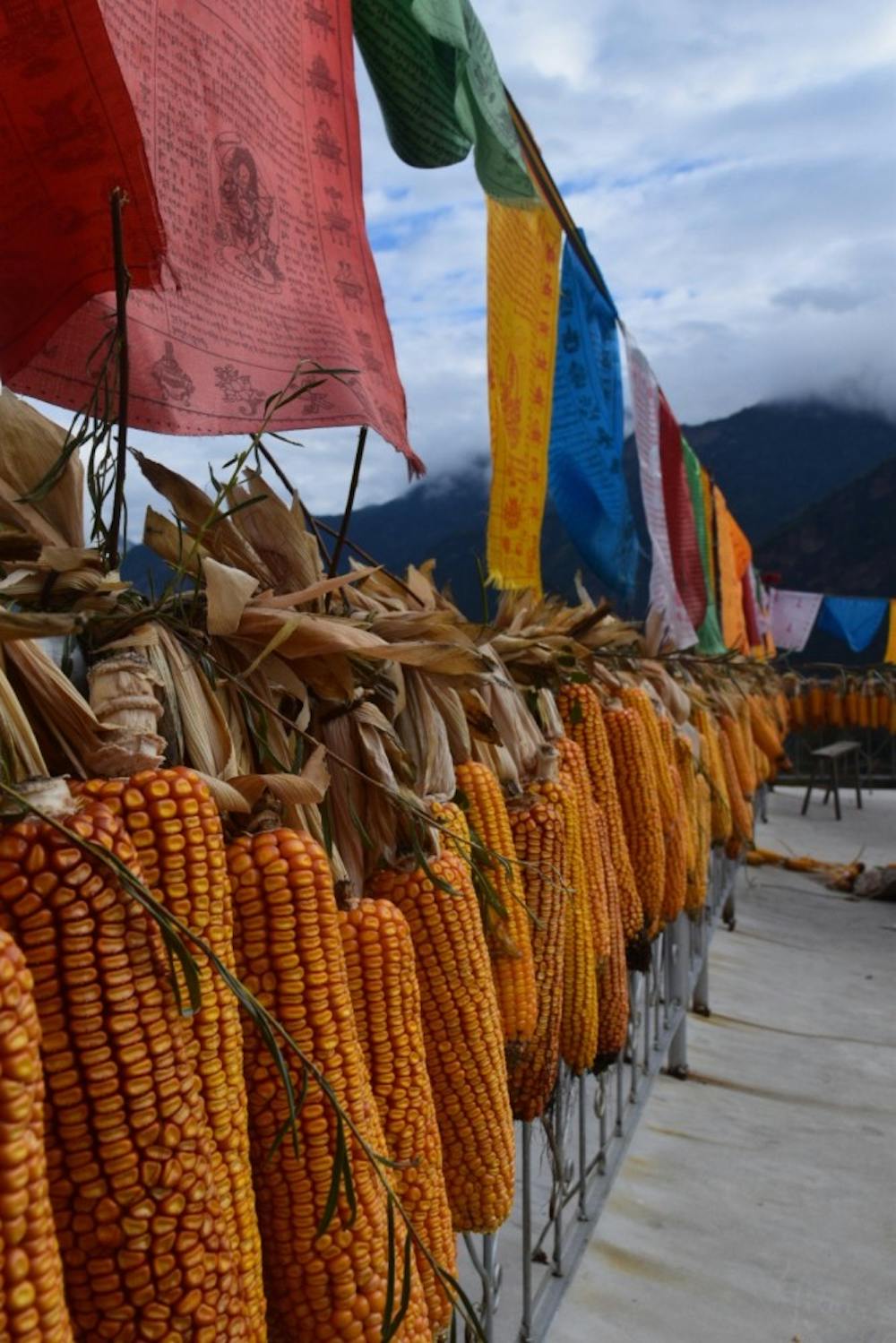The first week of October is one of China's two "Golden Weeks," celebrating the National Holiday. The other, held in January or February, celebrates the Chinese New Year.
All students, grade school through university, are granted the week off from classes for the annual event -- a popular time to travel with family and friends.
The international students at my host university, Southwest University of Nationalities, were no exception--I immediately talked to some friends, spoke with our program director and booked some bus tickets into Ganzi.
Ganzi is the Tibetan Autonomous Prefecture of Sichuan, and is one of the regions that makes Sichuan unique in the layout of China. Of the 56 ethnic groups in China, Han Chinese make up over 90 percent of the population -- conversely, Tibetan Chinese make up less than 0.5 percent.
Outside of Central Tibet or the Tibetan Autonomous Region, most of this population is located in Sichuan Province. Chengdu, the capital city of Sichuan with a population of around 15 million, is home to approximately 30,000 permanent Tibetan Chinese residents, though there is a floating population of around 200,000. Southwest University of Nationalities is located in the heart of Tibetan neighborhoods in Chengdu.
I had been surrounded by colorful Tibetan culture for over a month, but to gain a better understanding of it required a trip into Ganzi where 78 percent of its population of 880,000 are ethnically Tibetan people. A few friends and I made the decision to travel to Moxi, Kangding, and Zhonglu for National Holiday.
Moxi
After a seven hour bus ride -- or 20 hours if you're stuck in traffic "witnessing an entire country moving" as my program director said -- my friends and I were able to enjoy the small town of Moxi and nearby Hailuogou Glacier Park. The national park is home to an ancient forest, hot springs and glaciers.

The glacier in Hailuogou Glacier Park | Photo by Angela Day
Moxi hosts most of Glacier Park's visitors and is heavily reliant on the tourism that the park brings in. The town itself is composed of around two main streets, both lined with silversmiths, jewelry vendors, yak horn artisans and restaurants serving either Sichuan food, Tibetan food or some fusion of both.
Sichuan is known around the world for its spicy food, the main staples being kung pao chicken, fish-flavored eggplant, hot pot and mapo tofu. Mala peppers, or numbing peppercorn, and chili peppers are common ingredients in many dishes.
Tibetan food, on the other hand, is more of what would be considered hearty, cold-weather food. Meat is the center of every meal, and often makes up the side dishes as well. Yak meat is a must (and is absolutely delicious), accompanied by soups, potatoes, corn, thick breads and heaping bowls of rice.
Enjoy what you're reading?
Signup for our newsletter
There are fusions between Sichuan and Tibetan cooking that take from both groups. For example, in Moxi, we had yak noodle soup, a combination of Sichuan's spicy beef noodle soup and Tibetan's primary meat.
Kangding
Kangding is the capital city of Ganzi, located in a valley surrounded by a mountain range with a river running through the center. Tibetan culture is on display here, but outside of a tourist context. The city is considered the cultural boundary between Han Chinese and Tibetans, with a Tibetan population over 100,000.
Buddhism plays a central role in Tibetan culture, and the city is filled with colorful images of the Buddha, temples with enormous spinning prayer wheels and people in traditional Tibetan clothing turning prayer beads over between their fingers as they walk.

Four of my friends on top of Julian Mountain in Kangding | Photo by Angela Day
Mount Julian, the mountain our hostel was located on, is strung with Buddhist prayer flags and dotted with Tibetan family cemeteries. Just down the road from our hostel is a Buddhist monastery that opens its doors to the public every morning so that the people can pray with the monks. Many homes also reserve a decorated seat for the Dalai Lama, as is tradition, though they are not supposed to speak of this because of China's conflict with His Holiness and the larger issue of Tibet's protests for independence.
Tensions between Han and Tibetan people still flares up occasionally, some of which can be attributed to the freedom of Tibet and to the exclusion and clash of cultures. If conflicts becomes serious, the government sometimes blocks foreign tourists from entering Kangding for that period of time. Ethnic tension, between Han Chinese and all minority groups, is still quite high in China, and conflicts are generally resolved quietly to avoid stirring a national movement or raising the question of minority rights.
A very thin balance is maintained, often at the expense of one person's comfort based on their ethnicity and the circumstances of the situation. For example, my Chinese language professor told us about a conflict between her friend and a few women of the Yi ethnicity, which make up 0.65 percent of China's population and is also found in Sichuan. The women believed my professor's friend, a Han Chinese woman, was attacking one of their children while trying to break up a fight on the playground; that night, the Yi women beat my professor's friend with their shoes until she was sent to the hospital. When the conflict was brought to the police, the police brushed aside charges in favor of fining the Yi women, so as not to bring the question of Han versus minorities to any larger stage.
We did not witness anything to this extent during our trip in Ganzi, but it's a bitter grain of salt to swallow down alongside the beautiful scenery.
Zhonglu
Zhonglu, in contrast to Kangding, is a very, very small village located far up in the mountains above the city of Danba. A few classmates of ours were volunteering at the village's corn festival, and insisted we visit them on the last few days. The village is almost completely self-sustainable, with its small size and vast amounts of crops and water from the mountain top, but they are relying on money from tourism for funds to rebuild a school and to build indoor toilets.
The volunteers taught the people how to cater to tourists in order to draw more traffic. A few of my friends showed the hostel owners how to make modified Western foods using the foods they had available, and another gave lessons on outdoor safety when hiking and camping, such as how to build fires, where to pitch a tent and more.
The festival was also meant to encourage the younger generation to maintain and take pride in their culture. Our hostel owner told us over supper that the younger generation is falling away from the Tibetan way of life. While it's normal to see older people wearing the traditional clothing and speaking Tibetan, many children only speak the common dialect of Mandarin and dislike the formal wear.
Surveys have shown that the younger generation favor Mandarin because there are more opportunities for those who have mastered the common dialect while they see little advantage in spending time learning their mother tongue. This is not only an issue within the ethnically Tibetan communities, but also within other minority groups in China. The convenience and widespread nature of Mandarin is surpassing the importance of retaining culture in the eyes of the younger generations.
It used to be very difficult to navigate the Tibetan areas without knowledge of the language, but today a traveller is more likely to find Mandarin useful in getting by. There have been recent movements toward promoting Tibetan culture, with the opening of Tibetan language schools and offering bilingual options for classes within the Autonomous Region public schools, but a main part of the struggle to retain the minority cultures is changing the overall mindset towards them.
Our amazing week of travel within Ganzi came to an end in these mountains. Eventually my friends and I had to return to Chengdu to resume our studies. It was and exciting yet exhausting journey; the only thing I can think of changing is the timing of the trip. Golden Week is one of the busiest times of year to travel, and I would recommend to anyone interested in this area to visit during a less hectic time -- but, if that isn't possible, it is definitely worth the hassle.
As I write this in the comfort of my dorm room with indoor plumbing, located near convenient food and public transit, even if my legs are grateful to be located back on flat land in Chengdu, I know my heart is sold on those mountains in Ganzi.




